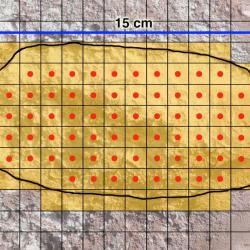Source Institutions
Source Institutions
Add to list Go to activity
Activity link broken? See if it's at the internet archive

In this activity (page 10 of PDF), learners approximate the area of the uppermost cross section of an impact crater using a variety of square grids. They conclude which angle of impact results in the greatest area. There are two versions of this activity: Challenge, where students construct a launcher and create their own craters; and Non-Challenge where students analyze pictures of craters. Includes a pre-lesson activity (p54). The Moon Math: Craters! guide follows a 5E approach, applying concepts of geometry, modeling, data analysis to the NASA lunar spacecraft mission, LCROSS.
- 10 to 30 minutes
- 45 to 60 minutes
- $5 - $10 per student
- Ages 8 - 14
- Activity, Lesson/Lesson Plan, Simulation
- English
Quick Guide
Materials List (per student)
- Shallow pan
- Soil-like substance
- Spherical projectile (description p6 of guide)
- Launching device (guidelines p5-6 of guide)
- Bed sheet (or other drape for spreading on the floor under the pan of soil)
- Transparencies of 3 different square grids: 2 cm x 2 cm, 1 cm x 1 cm, 1/2 x 1/2 cm (templates on pp. 41-43 of PDF)
- Tape
- Wet erase markers (1 light, 1 dark)
- Approximating Area Pre-lesson Activity student worksheet (p. 54 of PDF)
- Activity B – Crater Area student worksheet (p. 55 of PDF)
- Non-Challenge Version -- Activity A – Impact Crater Images (p. 52 of PDF)
Subjects
-
Earth and Space Science
-
Astronomy
- Probes, Satellites and Spacecraft
-
Solar System
- The Moon
- Asteroids and Comets
-
Astronomy
-
Mathematics
-
Data Analysis and Probability
- Data Collection
- Data Representation
-
Geometry
- Plane Geometry
-
Measurement
- Size and Scale
- Circles
-
Data Analysis and Probability
-
Physical Sciences
-
Motion and Forces
- Momentum and Velocity
- Projectile Motion
-
Motion and Forces
-
The Nature of Science
-
The Scientific Process
- Conducting Investigations
- Gathering Data
-
The Scientific Process
Audience
To use this activity, learners need to:
- see
- read
- be mobile
- touch
Learning styles supported:
- Involves hands-on or lab activities
Other
Includes alignment to state and/or national standards:
This resource is part of:
Access Rights:
- Free access
By:
- NASA
Rights:
- Public domain, ,
